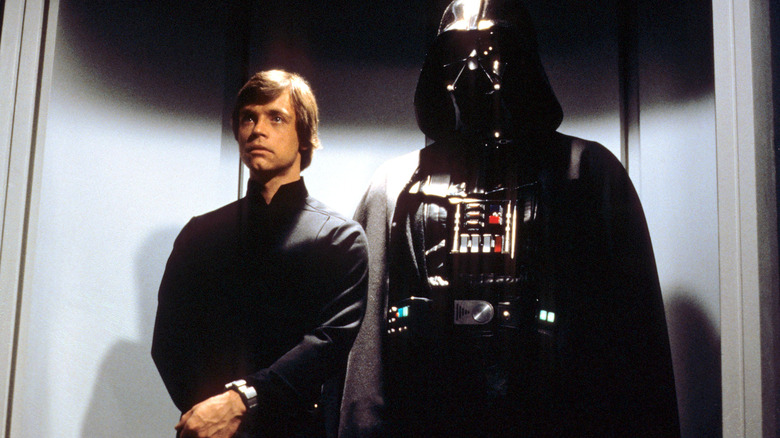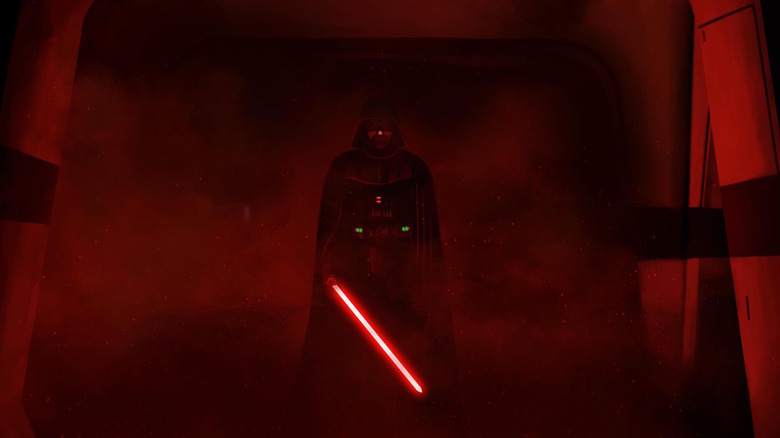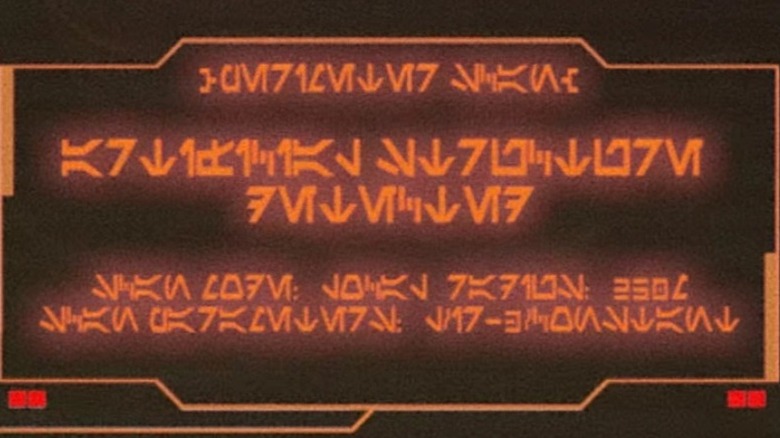What Does The Lettering On Darth Vader's Chest Plate Mean In Star Wars?
When it comes to the mythology of "Star Wars," fans might find that there is more knowledge and detail in expanded universe lore than there is on the screen. Darth Vader's suit, for instance, might merely look like an intimidating life-support system at first glance, and audiences can rightly interpret his mask as the respirator that keeps his lungs functioning. The black, swooping helmet he wears was simply part of an Empire uniform, meant to evoke helmets worn by Nazi soldiers during World War II. What did Darth Vader look like under the mask? In 1977, no one knew. The buttons and panels on Darth Vader's chest clearly fulfilled some sort of medical or engineering function, but audiences would never be told explicitly what they did in any of the "Star Wars" movies.
Of course, thanks to extensive expanded-universe lore, various technical sourcebooks, and endless tie-in novels, Starwoids now know every last detail of Darth Vader's suit and what every last button does. Did you know, for instance, that — according to Daniel Wallace's 2011 book "Darth Vader: A 3-D Reconstruction Log" – Vader's armor has a serial number? It's E-3778Q-1. Or that his helmet had been polished with woodoo hide in order to give it its shiny sheen? James Luceno's 2005 novel "Dark Lord: The Rise of Darth Vader" explained in several passages that Darth Vader's suit was actually terribly uncomfortable, leaving the Sith Lord chafed and aching most of the time.
The costumes worn by actor David Prowse in "The Empire Strikes Back" and "Return of the Jedi" have been put on display several times at the Smithsonian, and curious fans noted that, when seen up close, Darth Vader's chest panel contains curious "alien" lettering. The lettering, many might immediately note, is actually Hebrew.
Translating the Hebrew
One can find various photos online of Vader's chest panel, and those are indeed Hebrew characters. The inscription has been well-known to "Star Wars" fans going back many years, and several enterprising fans have claimed to know what it means. A web forum from way back in 1997 contained a post from someone calling themselves Anat who claimed to know what the Hebrew lettering might have meant. The post is a transcribed conversation between two fans who sussed out the lettering for themselves, while Anat corrected their assumption. The popular translation, based on that post — and still cited to this day — was "His deeds will not be forgiven until he merits." It was pointed out that Vader's Hebrew was of an ancient Biblical syntax and not modern Hebrew. Is it a prayer? A passage from the Old Testament?
Feeding the Hebrew lettering (מעשיו לא יסלחו, עד שיגיע) into Google Translate, however, gets a slightly different phrasing: "My actions didn't go away until they came."
Forgiven deeds? Actions that go away? There is a note of atonement and absolution in the inscription. It seems, however, that those words are not part of any sort of Yom Kippur prayers or any other Jewish rite for that matter.
To add to the mystery, several of the characters are written upside-down. No scholars appear to have contributed thoughts as to what it may mean in terms of translation, symbolism, or even numerology. The upside-down letters have led some to posit that the Hebrew lettering is merely jibberish. Indeed, it's entirely likely that the makers of Darth Vader's suit merely wanted lettering that looked alien, and copied a few random phrases out of a book, thinking that Hebrew looked otherwordly enough, especially with random upside-down letters.
Writing in Star Wars
Darth Vader, a genocidal murderer, has committed so many evil deeds that atonement doesn't seem possible, although some audience members have interpreted Darth Vader's murder of the evil Emperor at the end of "Return of the Jedi" as an act of penance. He may have killed billions, but Darth Vader at least, in a moment of conscience, put an end to the Empire. Of course, the First Order would rise in its place (as seen in "Star Wars: The Force Awakens"), so his actions didn't have a very long-lasting effect.
Some fans have seen the Hebrew lettering on Darth Vader's chest plate and theorized that it is not Hebrew, but a "Star Wars"-specific alien language that just happens to look an awful lot like Hebrew. A publicity photo of Darth Vader for "The Empire Strikes Back" gives a pretty clear shot of the alien language inscribed there, and fans have created an entire keyboard font to match. It looks a little squarer and more alien than the Hebrew writing linked to in the above slide. Indeed, some fans have delved so deeply as to notice very slight differences in the various Darth Vader panels that they appeared across the many "Star Wars" films. A deep analysis reveals alien lettering that most certainly does not resemble Hebrew.
On-screen writing is rare in "Star Wars." If one sees a signpost, it's written in a language called Aurebesh, first glimpsed in "Return of the Jedi." Aurebesh, however, wouldn't be given a proper alphabet until game-maker Stephen Crane authored one for his 1994 instructional book "Star Wars Miniatures Battle Companion." That language has since been folded into "Star Wars" canon, and can be seen on Coke cans at Disneyland's Galaxy's Edge attraction.
The Hebrew phrase for "Coca-Cola," by the way, is קוקה-קולה.


